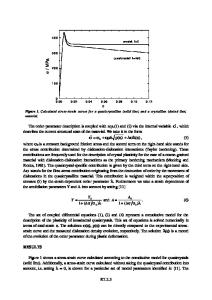Mechanism of Al-Cu-Fe Quasicrystal Plastic Deformation Studied by Instrumented Sharp Indentation
- PDF / 484,446 Bytes
- 6 Pages / 612 x 792 pts (letter) Page_size
- 23 Downloads / 349 Views
MECHANISM OF Al-Cu-Fe QUASICRYSTAL PLASTIC DEFORMATION STUDIED BY INSTRUMENTED SHARP INDENTATION Sergey N. Dub,1 Yuly V. Milman,2 Dina V. Lozko,2 and Anton N. Belous2 1
Institute for Superhard Materials, Kiev, 04074, UKRAINE, [email protected] Institute of Material Science Problems, Kiev, 03142, UKRAINE, [email protected]
2
ABSTRACT Cyclic nanohardness tests of Al65Cu23Fe12 quasicrystal reveals a different mechanism of plastic deformation as compared with a regular metal. For a polycrystalline metal, the indent depth increases monotonically with load, while for a quasicrystal, it increases stepwise. Probably, the step formation in the Al-Cu-Fe quasicrystal loading curve is due to the structural transformation in the indent. It is known that the quasicrystal structure destroys at high pressure and transforms into a regular crystalline structure. Therefore, it is possible to attribute the pressure drop in the indent to the transformation of the quasicrystalline structure into the crystalline one and extrusion of the plastic polycrystalline metallic phase out from indent. The observation of thin layers extruded out of the indent in Al-Cu-Fe quasicrystal supports this assumption. INTRODUCTION The stress-strain curves are widely used to characterize mechanical properties of metals and alloys. But the tensile tests of quasicrystals at room temperature are highly complicated due to the brittleness and small size of samples. Indentation tests allow us to extend the range of materials, for which the obtaining of a deformation curve is possible. The application of wedges [1] or Berkovich indenters [2] with a variety of included angles has permitted the obtaining of stress-strain curves in indentation experiments. In the present paper, we have obtained curves of elastic-plastic deformation during cyclic depth-sensing nanoindentation by a Berkovich indenter [3-5]. During the first loading/unloading cycle the initial indent was formed. Then indenter was subjected to a higher load. The reloading curve consists of the regions of elastic and plastic deformation of the initial indent. The reloading curve characterizes also the peculiarities of transition from elastic to plastic deformation. EXPERIMENTAL DETAILS Comparative cyclic nanoindentation studies of Al-Cu-Fe alloy in quasicrystalline state and a polycrystalline metal have been carried out. Al65Cu23Fe12 specimen was manufactured by sintering of gas-atomized powder under a quasi-hydrostatic pressure of 5 GPa [6]. As an example of a polycrystalline metal the hardened steel (standard hardness block for Matsuzawa MXT70 microhardness tester) was used with hardness close to the hardness of the Al-Cu-Fe quasicrystal. Nanoindentation experiments were performed using a Nano Indenter-II tester (MTS). Loading rate for reloading segment was 2 mN/s. To monitor the average contact pressure in the indent in reloading the indenter, the procedure suggested in [7] was used. The basis for this Q7.12.1
approach is the equation, which relates the elastic displacement, h, for simple punch
Data Loading...










